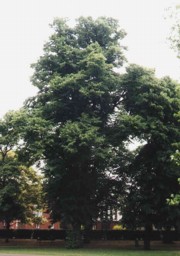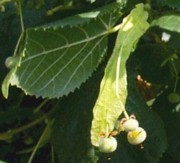

Common Name(s):
Lime Tree, Linden, Basswood,
Bast Tree, Spoonwood
Genus: Tilia
Species: x europaea

The common lime is a tall, stately tree, which grows in the deciduous forests of Europe, the British Isles, and the USA. In the USA it is known as a linden tree. It is the tallest broad-leaved tree in Britain. In the past it was found growing throughout the old growth forests of Europe. Today there are no original forests left there, but the common lime is still widespread because it is frequently planted along avenues and in gardens. The common lime can live up to 500 years.
The tree can grow to a height of 120-130 ft (25 m). Bushy side shoots grow along the trunk from near the ground. The lower branches arch out, giving the tree an upside-down pyramid look.
The leaves of the common lime grow singly along a stem but not opposite each other, and about 4-7 inches (5-10 cm) wide. They are roundish and slightly heart shaped with small, fine-toothed edges. Their color is a dull, dark green color above and lighter green underneath. The tops of the leaves are hairless but have tufts of white hairs at the junction of the veins underneath. The leaves often have small blisters caused by aphids and other sap-sucking insects.
Flowers of the common lime are yellowish to dull white in color and are sweetly scented. They hang from slender stalks in flattened clusters of 4-10 on a stalk. They have five petals and are about 1/2 inch (15 mm) wide. Insects attracted by the abundant nectar pollinate them. The common lime blooms in June and July.
The common lime fruit is a small round nutlet about the size and shape of a pea. Hairy and faintlyribbed, they hang together on green bracts. In October they float away from the parent tree on the wind.

The bark is smooth and a dull grey color when young. As it grows older, the bark becomes brownish-grey with perpendicular, shallow cracks. The stringy inner bark is called bass or bast. It is used to make mats, ropes, and fancy baskets.
The wood is white, smooth and close-grained. It is a light wood and doesn't become worm-eaten. It is useful for small things that don't need much strength. It is often used for carvings and the sounding boards for pianos, and for artist's charcoal.
The common lime has been used as a home remedy for colds, flu, coughs, epilepsy and indigestion. The inner bark contains a gelatin-like material that was applied to soothe skin irritations. Tea made from leaves and flowers is used to treat cold symptoms. However, drinking too much flower tea may cause heart damage.
During the Middle Ages statues of the Virgin Mary were carved from lime wood. They called the wood lignum sacrum, or sacred wood. In Germany the tree was thought to bring fertility and prosperity, and was considered the sacred tree for people in love.
Bibliography:
"Common Lime". http://doon.mayo-ireland.ie/limec.html (2/2/03).
"Common Lime". http://www-saps.plantsci.cam.ac.uk/trees/limec.htm (2/2/03).
"Common Lime - Medicinal Herbs Online" Copyright © 1996-2002 Internet Enterprises. http://www.egregore.com/herbs/commonlime.html (2/2/03).
Grieve, M.. Copyright 1995 © Electric Newt. "Botanical.com - A Modern Herbal |Lime Tree -..." http://www.botanical.com/botanical/mgmh/l/limtre28.html (2/2/03).
"Flora Species Detail View". http://www.reticule.co.uk/flora/content/species.asp?1729 (2/2/03).